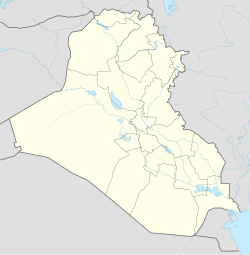Bab Al-Moatham باب المعظم | |
|---|---|
Neighborhood | |
 A picture of the Al-Bab Al-Muadham intersection and tunnel | |
 | |
| Coordinates: 33°21′15″N44°23′27″E / 33.35417°N 44.39083°E | |
| Country | |
| Governorate | Baghdad |
| District | Rusafa |
| Time zone | UTC+3 (AST) |
Bab Al-Moatham (Bab Al-Muadham or Bab Al-Mu'azzam) is a prominent landmark in Baghdad, Iraq. The name "Bab Al-Moatham" originates from the Al-Imam Al-Azam Mosque (also known as the Grand Imam Abu Hanifa Mosque), which is located near the area. Bab Al-Moatham was historically one of the gates of Baghdad during the Ottoman Empire, leading to the mosque of Abu Hanifa, a renowned Islamic scholar. The neighborhood lies to the north of central Baghdad, between the Al-Sarafiya Bridge and Al-Sinak Bridge, not far from the Tigris River.
Contents
The area of Bab Al-Moatham is rich in historical significance, with buildings dating back to the late Abbasid era, and it continued to be a vital area during the Ilkhanate, Jalayirid, Ottoman, and later Kingdom of Iraq periods, all the way up to the Republic of Iraq. In the past, it was sometimes referred to as Bab Al-Sultan (Gate of the Sultan), a name linked to the Turkish Sultan Toghrul Beg. The gate was demolished in either 1923 or 1932, and its location is now near the old Ministry of Defense, between the Sha'ab Hall and Azbak Mosque [1] .
During the British occupation of Iraq, there was an attempt to rename Bab Al-Moatham as the "North Gate" and Bab Al-Sharji as the "South Gate." However, the original Arabic names persisted, and these names were recorded in English as "north gate" and "south gate" [2] .
The neighborhood is also home to several significant institutions, including the Iraq National Library and Archive, a campus of the University of Baghdad, and Baghdad Medical City, which are landmarks of modern Baghdad. Additionally, it once contained the famous Garden of Ridván, which was a popular site in the city before its transformation over time.



